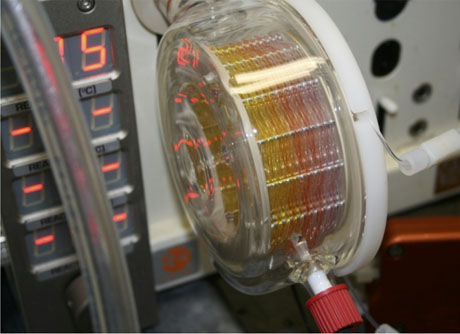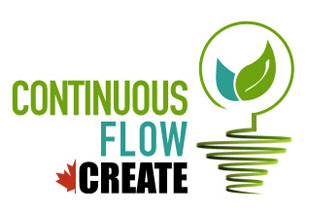What is Continuous Flow Science?
 Continuous flow science (CFS) has emerged as a cutting-edge technique to facilitate the way organic molecules are synthesized and analyzed both on small and large scales. Although this technology is just starting to be recognized as the way of the future, it certainly provides a novel, efficient and powerful approach to preparing molecules that traditionally employed tedious multi-step sequences involving chemical reactions, extractions and purifications. Unlike classical organic reactions that are usually carried out in round-bottom glass flasks and batch reactors, CFS employs microreactors, which consist of tiny channels allowing the chemical reactions to take place as a continuous flow of a solution containing the chemicals. The efficacy of the chemical reaction is improved over the conventional batch reactors due to the microreactors' narrow dimensions and the very large surface area-to-volume ratio. This results in a more efficient mixing of chemicals, more rapid heat transfer, more efficient control of chemical reactions and, consequently, a safer working environment. The use of microreactors also leads to shorter reaction times and improved yields and selectivities. Furthermore, CFS can be used to synthesize single target molecules either on a small scale or in industrial quantities as well as libraries of new molecules. From a sustainable development perspective, this technology is being seriously evaluated in medicinal chemistry and process R&D laboratories throughout the world, because of its numerous advantages for manufacturing, namely increased efficiency, safety as well as cost-saving and environmentally-friendly processes.
Continuous flow science (CFS) has emerged as a cutting-edge technique to facilitate the way organic molecules are synthesized and analyzed both on small and large scales. Although this technology is just starting to be recognized as the way of the future, it certainly provides a novel, efficient and powerful approach to preparing molecules that traditionally employed tedious multi-step sequences involving chemical reactions, extractions and purifications. Unlike classical organic reactions that are usually carried out in round-bottom glass flasks and batch reactors, CFS employs microreactors, which consist of tiny channels allowing the chemical reactions to take place as a continuous flow of a solution containing the chemicals. The efficacy of the chemical reaction is improved over the conventional batch reactors due to the microreactors' narrow dimensions and the very large surface area-to-volume ratio. This results in a more efficient mixing of chemicals, more rapid heat transfer, more efficient control of chemical reactions and, consequently, a safer working environment. The use of microreactors also leads to shorter reaction times and improved yields and selectivities. Furthermore, CFS can be used to synthesize single target molecules either on a small scale or in industrial quantities as well as libraries of new molecules. From a sustainable development perspective, this technology is being seriously evaluated in medicinal chemistry and process R&D laboratories throughout the world, because of its numerous advantages for manufacturing, namely increased efficiency, safety as well as cost-saving and environmentally-friendly processes.
Research in the CREATE-CFS program is divided into three (3) different themes, which are set to support the research objectives of the program:
- the invention of novel chemical synthetic CFS processes;
- the development of new analytical tools for CFS applications;
- the understanding and implementation of the engineering principles;
- and the design impact on new CFS processes.
Experts: André Charette, Shawn Collins, Stephen Hanessian, Hélène Lebel, William Lubell, James Wuest.
The development of efficient CFS processes that produce important compounds while minimizing or eliminating the handling of hazardous chemicals, solvents or intermediates and at the same time attaining high yields and selectivities is a tremendous challenge. Many traditional chemical reactions using "in batch" manufacturing need to be re-optimized or transformed to become efficient and applicable to CFS. Consequently, a significant portion of the CREATE program is being devoted to the development of novel CFS synthetic processes. One focus is the development of novel catalytic chemical strategies, given the pivotal role they play in modern manufacturing. CREATE researchers are investigating a number of synthetic strategies that are currently under development in CFS. Another focus is on new applications of homogeneous catalysis in flow, for instance, the creation of multicatalytic strategies, whereby a single catalyst system can be harnessed for multiple sequential transformations in a continuous system and can reduce waste and energy consumption. The invention of new reactions using high-energy reactants, which are traditionally shunned in batch reactions but can be safely exploited in continuous flow, can open new routes to chemical entities critical for both fine and bulk chemical synthesis. Research in the area of homogeneous catalysis is also exploring new frontiers in chemical transformations that could open promising avenues for chemical manufacturing. Biocatalysis is one such field, as enzyme-catalyzed reactions typically offer high selectivity, a desired criteria for chemical manufacturers. Synthetic photochemistry is a second field that emerges as a powerful tool to perform complex chemical transformations and afford high value products, typically using low energy light. Homogeneous catalysis is also being investigated in non-conventional solvent systems (e.g. ionic liquids), that are non toxic and non volatile. Heterogeneous catalysis, exploiting immobilized catalysts, is highly valuable too, as it represents a recyclable and sustainable manufacturing process. Microwave-assisted CFS on novel heterogeneous and homogeneous processes is also being explored.
Experts: Jean-François Masson, Arturo Macchi, Gregory Patience, Maryam Tabrizian.
The development of efficient CFS processes is intimately linked to the "tubing" exploited for manufacturing processes. The design of novel reactors, with an in-depth understanding of the engineering factors, is important when developing both synthetic and analytical flow systems. The CREATE program aims to exploit microfluidic devices in both analytical and synthetic applications. The high surface area-to-volume ratio in microfluidic devices often affords unique opportunities for exquisite chemical control and energy transfer. One example of a synthetic focus is to exploit microfluidics in photochemical processes where it is possible to have highly efficient photon flux and greatly enhanced chemical reactivity, which can open new pathways for the synthesis of critical chemical entities. The manipulation of multiphase flows is another strength of microfluidic systems. They enable the generation and manipulation of monodispersed bubbles or droplets of a dispersed gas or liquid phase in a continuous liquid stream; these dispersions suggest new routes for the development of efficient CFS processes. Considering that parameters, such as pH, ionic strength, ionic composition, co-solvents and concentration can be screened, the microfluidic devices are also very promising microreactors for many chemical syntheses. However, chemical synthesis (especially organic and medicinal chemistry) – an area in which microfluidic systems is deemed to fit naturally – has been slow to adopt microfluidic devices as a strategy for the development of new capabilities. CREATE researchers are currently involved in the development of silicon, glass or polymer microfluidic devices requested for many CFS processes that enable the use of different solvents, reactions at various pH, high temperatures and pressures.
Experts: Jean-François Masson, Maryam Tabrizian, Alexis Vallée-Bélisle.
Novel methods for qualitative or quantitative analysis of non- or pre-processed samples that involves CFS principles are being studied, with an emphasis on electrochemical, fluorescence, surface plasmon resonance and surface-enhanced Raman spectroscopy techniques. Of particular interest is the development of novel biosensing strategies using the aforementioned techniques, which exploit the integration of microfluidic and surface functionalities in microfluidic channels using CFS. The versatility provided through this integration permits the fabrication of novel micro total analysis systems (micro-TAS) of various thicknesses (micrometer to nanometer) to achieve the required industrial analyses. For instance, powerful tools can be developed to investigate sub-millisecond chemical reactions, such as protein folding and enzymatic reactions. CFS microfluidic systems also have distinct advantages over traditional bulk methods for biomedical applications: they can replace traditional separation techniques, such as filtration, centrifugation, chromatography or electrophoresis. CREATE researchers are using continuous flow microfluidic platforms for separation of DNA of various molecular weights and for separation of various living cell types. In addition, since these systems allow for particle formulations with unprecedented homogeneity and fine control over the critical process parameters, they are currently investigating the fabrication of liposomes for drug delivery applications using CFS processes. That way, they demonstrate the medical applications of continuous flow microfluidics devices and provide a diverse toolbox based on CFS methods that are likely to play an important role in future point-of-care or in-the-field analysis devices.

